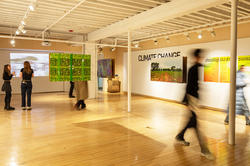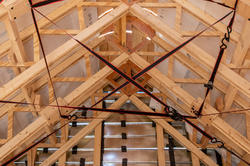A daylong conference organized by Assistant Professor Amelyn Ng brings together artists, architects, scholars and urban planners from across the Americas.
Architectural Practices in a Post-Extraction World
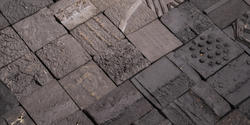
“Construction has long been known as a growth industry, where material expenditure is geared towards ever greater gross domestic product (GDP),” says Assistant Professor of Architecture Amelyn Ng. “We offer another definition: gross domestic practices, a total-practice approach that recognizes building maintenance, waste work, ecoservices and the material limits of growth.”
Ng discussed her latest project, D.E.P.O.T.—along with collaborators Gabriel Vergara, an architect and urban designer from Chile, and NYC-based architect and filmmaker Christine Giorgio—at a closing reception in RISD’s Bayard Ewing Building in late September. The conceptual project/exhibition was on view in the Architecture department space since the beginning of the fall semester, and faculty members and students came out in force for the closing discussion.
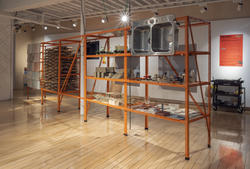
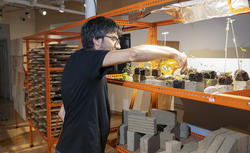
The objects on view, which have all been 3D-scanned for the project website (a kind of digital salvage yard), were divided into four categories: dust, wood, earth and hardware. Visitors were invited to peruse the assembled doorknobs, light switches, seedlings grown in salvaged soil, old-growth lumber collected from a barn in Connecticut, handmade tiles and bricks before joining the panel discussion, which also featured visiting architect Ang Li and RISD faculty members Debbie Chen and Gavin Zeitz MLA 18.
“We’re attempting to reframe the narrative about these objects from refuse to relics,” Giorgio noted as the team recounted their research journey for the larger group. Over the course of the past six months, they visited NYC’s Clean Soil Bank (where dirt excavated from construction sites has been collected and shared since 2011), various New England salvage yards and natural Rhode Island habitats where they were able to gather clay, marsh grasses and other materials with which they experimented.
Vergara applauded ongoing “depaving” efforts, in which practitioners tear up asphalt and concrete in order to make way for water and vegetation, and walked viewers through the team’s efforts to use recycled resources to create tiles, bricks and other environmentally friendly building supplies. But the big question on everyone’s minds was the scalability of such efforts. As Vergara put it, this kind of work is the “opposite of mass production.”
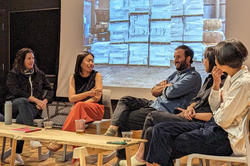
“Is there a way to assemble that takes into consideration disassembly and a project’s end of life?”
“We’re really talking about the intense labor of undoing, versus the ease of doing (hammering nails, painting boards, hanging drywall),” said Ng. “Is there a way to assemble that takes into consideration disassembly and a project’s end of life?”
Such discussions, though heartening, are not new, and people across the country and around the world have been passionately working to recycle materials for decades. But many such projects, including the incredible installations by Ghanaian artist Ibrahim Mahama, have been more about drawing attention to the problem than about finding scalable solutions, says Giorgio.
“Construction and demolition waste is in fact routinely salvaged, transported, sorted, cleaned, labeled, stored and recombined for future recirculation,” the group explains on their website. “Such laborious local practices exceed the scopes and budgets of construction, yet they are crucial in taking stock of an industry overwhelmed by extraction.”
Simone Solondz / photos by Tam Stockton MFA 25 PH
October 16, 2023
